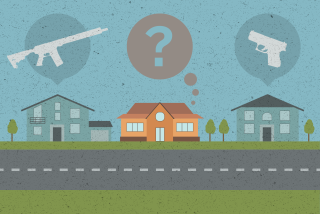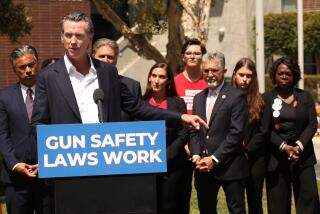Editorial: New reports confirm what should be obvious: Smart gun laws save lives

A fresh round of studies affirms what gun control advocates have been arguing for years: Smart laws restricting easy access to firearms mean fewer people dying at the end of a gun barrel. And in the midst of yet another cycle of panic gun buying by consumers, Congress and state legislators need to fight off the influence of the gun lobby and expand rules that could make all of us safer.
A new Rand Corporation report estimates there are 11% fewer gun deaths in states with the most restrictive laws governing how guns are stored in the home (reducing child access to the weapons), who can carry firearms outside the home and when it may be lawful to use lethal force in personal confrontations (so-called “stand your ground” laws). In raw numbers, that’s about 4,475 deaths avoided per year in those states.
Notably, about six in 10 gun deaths in the U.S. each year are suicides.
An ambitious study published earlier this month in the New England Journal of Medicine tracked nearly 700,000 Californians who bought their first gun between 2004 and 2016, and followed them for up to 12 years and two months. It found that men were eight times as likely to shoot themselves over the 12 years after that first gun purchase than nongun owners.
Trump’s rally in Tulsa, site of the nation’s worst massacre of blacks by whites, on Juneteenth could be a healing moment. But you know it won’t be.
Women shoot themselves to death far less often than men, yet the female gun buyers in the studied group were found to be 35 times more likely to kill themselves than women who didn’t own guns. Even more interestingly, the study’s authors wrote that “handgun owners’ risk of suicide by firearm peaked in the period immediately after their first handgun acquisition but remained relatively high 12 years later, and the long-term risk accounted for a majority of the excess suicides by firearm among owners.”
So the purchase of that first firearm has a lethal legacy. Ironically, most people who buy guns say they do so for self-protection, even though violent crime has decreased considerably over the last quarter-century. Yet incidents of gun owners using the weapon in self-defense are minuscule compared to the number of people — led by middle-aged white men in rural areas — who use the weapons to kill themselves.
This is not new knowledge. Prior studies have pointed out that suicide is often an impulsive act, that most first attempts fail and that the person in crisis does not make a second attempt. But when a gun is introduced into the equation, only a statistical handful survive that first attempt. Related, a 2008 study by the Harvard School of Public Health found that states with high rates of gun ownership have the highest rates of suicide.
America responded to the 1980s crack epidemic with police and prisons instead of public health. Now look where we are.
Now for the most troubling part. Since the start of the pandemic, Americans are buying more guns. The FBI says it conducted a record 3.7 million background checks for would-be gun buyers, a loose proxy for firearm sales, in March as lockdown orders spread across the nation. In April the checks dropped to 2.9 million but rebounded to 3.1 million in May. The monthly average for 2019 — itself a record year for background checks — was 2.4 million. So even as we get fresh studies connecting possession of firearms with increased risk of gun violence, accidental shootings (usually by children) and suicides, we are adding more firearms to the nation’s already numbingly large privately owned arsenal of some 300 million guns (no reliable count is available) owned by about a third of the population.
This is madness.
One bit of good news came Monday, when the U.S. Supreme Court declined to take up a range of cases that could have further expanded the court’s (ill-considered) view of the 2nd Amendment, morphing the right to own a firearm for protection in the home into a right to carry a firearm wherever you go. Many states already allow that as a matter of policy, which is dangerous enough. (California generally bars openly carrying a firearm, and limits possession of a concealed weapon to people who have been issued licenses, usually by a county sheriff.)
Even if people believe in a 2nd Amendment right to own firearms, it’s not unreasonable to ask that they support laws barring firearm access to those who pose a risk to themselves and others, requiring safe storage of weapons in the home, and other reasonable measures to try to reduce the number of gun victims. And given the increased risk that the gun you buy today may become your own cause of death, you might want to rethink why you believe you need a gun in the first place.
More to Read
Updates
12:39 p.m. June 15, 2020: This editorial was updated to reflect the Supreme Court’s decision Monday not to hear appeals on a group of gun-control lawsuits.
A cure for the common opinion
Get thought-provoking perspectives with our weekly newsletter.
You may occasionally receive promotional content from the Los Angeles Times.







